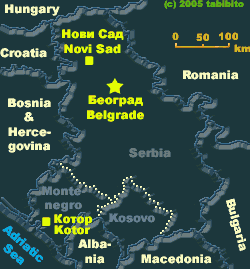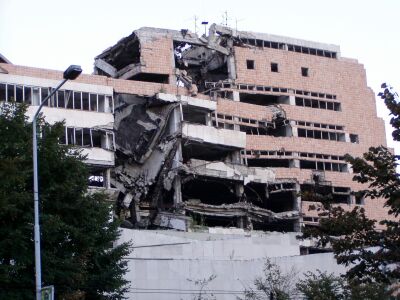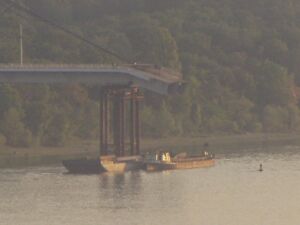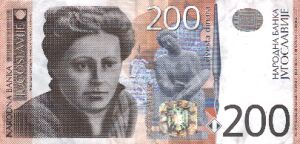|
|
|
|
|
|
 Official name: Србија
и Црна Гора
(Srbija i Crna gora) - the official name
is Serbia and Montenegro (abbr:
SCG), which is a union of the two equally
ranked republics (ie what is left of Yugoslavia).
Some people still refer to it as Југославија
(Yugoslavia). The union include(d) two
autonomous districts: The Kosovo
in the south, which is under UN administration
by now, and the Vojvodina
in the north of Serbia. However, the autonomous
status of the Vojvodina was abolished some years
ago. This website is exclusively about Montenegro
and the Srbska Republika
- the Serbian Republic - which should not be confused
with Republika Srpska (one
of the two entities in →Bosnia-Hercegovina).
Area: About 102,000
km² incl. Montenegro (equal to the size of
Iceland or Kentucky); Serbia alone covers 88,361
km² (same as Scotland).
Population: slightly
less than 10.7 million* (2003); incl.
Montenegro. Serbia without the Kosovo has around
7.5 million people (official figure).
Ethnic groups: around
63% are Serbs, 16.5% Albanians (almost all of
them live in Kosovo), 5% Montenegrins, 3.3% Hungarians,
12.6% others (Macedonians, Romanians, Roma etc).
All of these figures are from 1991 and therefore
definitely subject to change!*
Religion: 65% are
Serbian-Orthodox, 19% Moslems, 4% Roman-Catholic,
1% Protestants, 11% others*
Time zone: As in
middle Europe: GMT +01 hr, with daylight-saving
time (+1 hour) in summer.
Language: Serbian. Until
the 1990ies, the language was referred to as Serbo-Croatian,
but now it's regarded as a single language. In
contradiction to →Croatian,
the Cyrillic script is used in Serbia and Montenegro.
Serbian as well as Croatian belong to the South
Slavic language group. Serbian is also used
in wide parts of →Bosnia.
Serbian and Croatian are indeed quite familiar,
but there are characteristic differences in vocabulary,
pronunciation and partially even in grammar. To
give an example, a long Serbian [e] is often pronounced
[ije] (pron: iye) in Croatian. Hence, the Serbian
word [ reka ] (=river) becomes [ rijeka ] in Croatian.
On the other hand, a short Serbian [ e ] is sometimes
pronounced [ je ] in Croatian. Serbian uses most
of the Cyrillic letters you will also find in
Russian, but there are several exceptions:
Official name: Србија
и Црна Гора
(Srbija i Crna gora) - the official name
is Serbia and Montenegro (abbr:
SCG), which is a union of the two equally
ranked republics (ie what is left of Yugoslavia).
Some people still refer to it as Југославија
(Yugoslavia). The union include(d) two
autonomous districts: The Kosovo
in the south, which is under UN administration
by now, and the Vojvodina
in the north of Serbia. However, the autonomous
status of the Vojvodina was abolished some years
ago. This website is exclusively about Montenegro
and the Srbska Republika
- the Serbian Republic - which should not be confused
with Republika Srpska (one
of the two entities in →Bosnia-Hercegovina).
Area: About 102,000
km² incl. Montenegro (equal to the size of
Iceland or Kentucky); Serbia alone covers 88,361
km² (same as Scotland).
Population: slightly
less than 10.7 million* (2003); incl.
Montenegro. Serbia without the Kosovo has around
7.5 million people (official figure).
Ethnic groups: around
63% are Serbs, 16.5% Albanians (almost all of
them live in Kosovo), 5% Montenegrins, 3.3% Hungarians,
12.6% others (Macedonians, Romanians, Roma etc).
All of these figures are from 1991 and therefore
definitely subject to change!*
Religion: 65% are
Serbian-Orthodox, 19% Moslems, 4% Roman-Catholic,
1% Protestants, 11% others*
Time zone: As in
middle Europe: GMT +01 hr, with daylight-saving
time (+1 hour) in summer.
Language: Serbian. Until
the 1990ies, the language was referred to as Serbo-Croatian,
but now it's regarded as a single language. In
contradiction to →Croatian,
the Cyrillic script is used in Serbia and Montenegro.
Serbian as well as Croatian belong to the South
Slavic language group. Serbian is also used
in wide parts of →Bosnia.
Serbian and Croatian are indeed quite familiar,
but there are characteristic differences in vocabulary,
pronunciation and partially even in grammar. To
give an example, a long Serbian [e] is often pronounced
[ije] (pron: iye) in Croatian. Hence, the Serbian
word [ reka ] (=river) becomes [ rijeka ] in Croatian.
On the other hand, a short Serbian [ e ] is sometimes
pronounced [ je ] in Croatian. Serbian uses most
of the Cyrillic letters you will also find in
Russian, but there are several exceptions: 
- Ђ ( ђ
) Close to [ dsh ]
(phon: ɟ ), read as the [ du ] in [ education
] (but softer). In Latin script, this letter
is written Đ (
đ ).
- J ( j ) Not
very commmon in Slavic alphabets. Pronounced
as the [ y ] (phon:
j) in [ yes ].
- Љ ( љ
) A mixture of 'L' and the 'soft sign',
pronounced as the [ li ]
(phon: lj) in [ million ].
- Њ ( њ
) A mixture of 'N' and the 'soft sign',
spoken as the [ ny/ñ
] (phon: nj) in [ cañon/canyon
].
- Ћ ( ћ
) is close to the [
tch ] (phon: ɕ ) in [ kitchen].
In Latin script this letter is written Ć
( ć ).
Because of these 'special' characters, some other
typical Cyrillic letters are not used in Serbian
and/or substituted by other letters, as there
are я → ja (ya),
ю → jy (yu),
щ (shtch, not
existent), ъ
(hard sign, not used) and ь
→ ђ, њ, љ. A basic
knowledge of Russian for example is very helpful,
although some important words are completely different:
'Thank you' for example is [ спасибо
= spasibo ] in Russian, [
благодарам
= blagodaram ] in Macedonian but [
хвала = hvala ]
in Serbian.
For a table with the most important words in Macedonian
and other Slavic languages please →click
here.. Anyway, it's not so problematic to
get by in English and even
in German (chances are higher
to meet someone speaking the latter).
|
|
|
|
|
|
|
Serbia itself is landlocked - the entire Adriatic
Sea coast belongs to rather mountainous Montenegro.
Geographically spoken, Serbia can be divided into
two main parts - the North and the South. Between
the two parts, the mighty river Дунав
(Dunav, Danube) flows from the west to the
east. The Serbian part of the river Danube is 588
km long and therefore Serbia's most important river.
In the east, the Danube marks the border to →Romania,
in the west the border to →Croatia.
The south is characterised by mountains and large
plateaus - including the Kosovo. The highest peak
is called Ðeravica, has
an altitude of 2,656 metres and lies in Kosovo.
The area north of the river Danube is mostly flat
and characterised by a criss-cross of countless
canals. The plain has very fertile soils and therefore
it can be called Serbia's granary. Furthermore,
smaller quantities of crude oil are exploited in
the north. There are only six big cities (big city:
defined as a town with more than 100,000 inhabitants)
in the country: Among them Ниш
(Niš), which is the centre of the southern
part, Суботица
(Subotica aka Szabadka) in the north, →Нови
Сад (Novi Sad) and the dominating
capital →Београд
(Belgrade, Beograd) (the others are Kragujevać
and Priština, Kosovo). |
|
|
|
|
|
|
Some thousand years ago, the region around present-day Serbia was inhabited first by Illyrian,
later on by Celtic tribes. The Roman Empire conquered the land already during the 3rd century BC and
named it Moesia Superior. The river Danube marked the northern border of the province.
In the year 395 AD, the Roman Empire split into two parts. Ever since, Serbia belonged to the Byzantine Empire,
whereas present-day Croatia became a part of the West Roman Empire.
During the 6th century, first Slav tribes entered the region, namely Slovenes, Croats and Serbs.
All of these tribes converted to Christianity around the year 895. This was mostly thanks to the two monks Cyril and Methodius.
For the first time in history, an independent Serbian Kingdom was founded in the year 1217.
During the reign of Stefan Dushan in the 14th century, Serbia experienced its heyday. At that time, many monasteries
were built. Things changed dramatically after his death - Serb forces were defeated at the decisive battle of
Косово Поље (Kosovo Polje, polje=field) by the Ottomans
in the year 1389. Since then, Serbias was occupied by the Ottoman Empire for almost 500 years. The first large and partially
successful uprising took place in the year 1815. Serbia became quasi-independent and was granted greater autonomy in 1829.
However, it couldn't gain full independence before the year 1878.
In 1914, a young Serb assassinator killed Archduke Ferdinand in
→Sarajevo. This event lit the powder keg. As a result of the assassination,
the →Austro-Hungarian Monarchy annexed Serbia which marked the
beginning of the First World War. After the end of the war and the defeat of the monarchy,
→Slovenia, →Croatia and the
Војводина (Vojvodina) united with Serbia,
Montenegro and →Macedonia. The Kingdom of Slovenes, Croats and Serbs was
eventually renamed Yugoslavia (Country of the Southern Slavs) in the year 1929.
In 1941, Yugoslavia first joined the fascist Berlin-Rome-Tōkyō axis, a decision that initiated a
coup d'état). As a result of the coup, Peter II. became king and made a U-turn by leaving the axis.
This of course caused Hitler to march in and occupy the country, just to share it between Germany, Italy,
→Hungary and →Bulgaria.
Almost immediately, the Communist Party led by Josip Broz Tito became active and declared armed resistance against
the occupiers.
In 1945, after the end of World War II, the Communists finally took over and abolished the monarchy. Bosnia, Montenegro and
Macedonia were granted the status of a republic inside the federation - Croatia, Slovenia and Serbia had this status already before the war.
However, republican status was denied to Albanian-dominated Kosovo as well as to the Hungarian-dominated Vojvodina.
The fact that these two regions hadn't had republican status before the war and never belonged to the 'old' Yugoslavia was
used as the main reason for the denial. And so the Federal Republic of Yugoslavia, ie the 2nd Yugoslavia, was born.
→Belgrade was declared capital of the federation.

| |
Traces of NATO air raids in the centre of Belgrade
|
This fragile, artificial structure called Yugoslavia didn't last longer than until 1986. It was at the latest in that year, that the seal was set on the collapse
of the federation. The Serbian Academy of Sciences commited intellectual arson by calling for greater
Serb domination in Yugoslavia. In 1987, Slobodan Milošević became the head of the ruling
Communist Party and started mixing the party statutes with Serbian nationalist ideas. This frightened the people of the other republics, and so
→Slovenia and →Croatia
declared independence. Further events came hot on the heels of the declaration. The Serb dominated JNA
(Yugoslav National Army) annexed Slovenia. After a few minor fights during the so-called 10-days war, the JNA pulled out their troops, because
there weren't any Serb claims on the country. In 1992, the EU recognized Slovenia and Croatia as independent countries and imposed an arms embargo on
the rest of Yugoslavia (at least!).
Soon after, heavy fights erupted in Croatia over the so-called Krajina Serbs (for more information on the Krajina-Serbs see
→History of Croatia). Inevitably, the now full-scale war between Croatia and
Serbia was soon to expand into →Bosnia-Hercegovina. Bosnia tried to
gain independence as well - and so did →Macedonia at the same time. The big difference was
that Macedonia was only of marginal interest to Serbia. And so Macedonia was the one and only former Yugoslav republic that mamaged to get away
without firing a single shot. In Bosnia-Hercegovina, the war was about to become particularly brutal. It developed into an ethnic
conflict between all races and religions - both of them didn't play a big role before. →Sarajevo
suffered a three-years siege, leaving an estimated 10,000 civilians dead. Serbia (as well as Croatia!) tried hard to gain as much control over
Bosnian territory as possible. The UN, represented by the so-called UNPROFOR, was present but absolutely helpless.
And so Serb militia could drag the Bosnian vice president out of an armoured vehicle just to shoot him in front of the UNPROFOR soldiers.
Also, the UN was not able to prevent thousands of civilians from being slaughtered after the fall of Srebenica - actually one of the so-called UN protected
areas. The incident is now known as the Srebenica massacre. The whole, awkward dilemma is well (not to say too well!)
depicted by the British movie "Warriors".

| |
Bridges were primary targets of NATO air raids
|
It's not quite clear how things will go on in Serbia. After the long overdue deposition of Milosevic things started to
look much better. Democratic as well as economic reforms were initiated. However, the
assassination of the prime minister Zoran Ðinđić in 2003 was quite a big shock and left many things
open to question. Nevertheless, it's easy to believe that Serbia has developed into a normal, peaceful country when you walk around
→Belgrade or →Novi Sad. But what's under the surface? How will things
go on in Kosovo? What does the majority of Serbs think about the recent EU-friendly line of the government? I would like to believe that the
bloody chapter called the Balkan conflict is over, but I'm afraid it isn't.
|
|
|
|
|
|
|
Prologue:
The Serbian government have substantially relaxed their extremely rigid visa policy in May 2003, and so it became
easy to travel to Serbia (before 2003 it was already possible to enter Montenegro without a visa). And
I'm thankful for this opportunity - Serbia is a very rewarding destination. We've only made it to
→Novi Sad and →Belgrade, and both places were
very cosmopolitan and people were friendly, too. What about the rest of the country!? We've also been
to → Kotor in Montenegro years before, and that town became one of my very favourite
spots in the Balkans.
Visa: Since May 2003, many nationalities do not require a visa any longer.
A passport which is still valid for several months upon arrival is all you need. The passport will be stamped and
that's it. Welcome to Europe. At the border, we didn't trust the simplicity and asked whether it would be necessary
to register with the police. The answer was 'no', but according to the border police we should collect the
papers we'll get from hotel staff, confirming that we stayed there. However, no one asked for the paperwork when we
left the country. Still it might be wise to not throw them away.
Money:
Ex-Yugoslavia had its own currency, but during the 1980ies, hyperinflation was plaguing the
economy and the people. Later on, the Novi Dinar (New Dinar) was introduced.
During the war, most people used the more stable Deutschmark.

| |
The new, old Yugoslavian 200-Dinar banknote
|
Thanks to the liberal financial policy, first ATM's were set up in
→Belgrade and by the time you read this probably in other cities as well.
Serbian ATM's are European standard and accept all major credit cards as well as Cirrus and Maestro cards.
When we were in Serbia, ATM's were very new and we were not sure about the exchange rate, so we better
stuck to cash.
Attention: It's virtually impossible to exchange Serbian money outside Serbia.
Neither exchange booths in →Hungary nor in the
→Czech Republic accepted Dinar (which means
that I'll have to go there again - with pleasure).
Costs:
For travelers, Serbia is an inexpensive destination. Almost everything is much cheaper than let's say
→Skopje or →Hungary.
Despite the two-tiered price system, i.e. foreigners have to pay a considerably higher price for a hotel rooms,
it's possible to stay in the capital for around € 10 (we've paid € 22 for a double with bathroom and incl. breakfast).
In food stalls, it's possible to have a decent meal for € 1 or so.
Bus and train tickets are relatively cheap as well. Of course, international train tickets,
for example to Hungary, are substantially more expensive.
Getting there: By bus, train, plane or car - everything is possible.
And most nationalities (sorry, Aussies!) do not require a visa for the neighbouring countries. There are several
direct flight connections from major airports in Europe to Belgrade. But
Serbia will never be popular with holidaymakers, so there will never be any
charter flights.
There are several long-distance buses, especially from Germany, Austria and Switzerland,
running to Serbia. However, it's a gruelling journey with many stops at several border crossings.
Nevertheless it's the cheapest way to get there - except for hitchhiking of course. There are also some
buses to destinations in the neighbouring country, as for example to →Macedonia,
→Bulgaria and →Bosnia-Hercegovina
(for the latter the bus is the only option). It's not recommended to cross the border to Kosovo from Serbia.
There are also some interesting train connections to Serbia. There are direct trains to
Belgrade from →Sofia, →Zagreb,
Thessaloniki (via →Skopje),
→Budapest, Vienna, →Bucharest
and also to Munich via →Ljubljana.
The trip from Belgrade to Skopje takes around 9 ½, the fare is € 15. The ticket from
→Novi Sad to Budapest costs € 30, the ride takes 6 hrs. There are also several
trains from Belgrade to the Montenegrin coast. But the only way to get to Montenegro from →Dubrovnik
and other towns in →Croatia is by bus. See the getting there
chapter of Dubrovnik. Trains to destinations in Kosovo are still out of service.
Border crossing: :
Serbia and Montenegro share border crossings with Albania (all of them in Montenegro and Kosovo),
→Bulgaria, →Macedonia,
→Croatia, →Bosnia-Hercegovina,
→Hungary and →Romania.
As far as I know, all border crossings can be used by foreign travelers, too. However, according to various reports, it's still
not recommended to cross the Serbian-Kosovo border.
Food & drinks:
Čevapčići and Pljeskavica,
Razvnjići and Duveč - grilled meat has many
names in Serbia. But it can be really tasty. Sometimes, the meat is fried with cheese or vegetables and
served with bread, rice or fried potatoes. Salads are very common, too. In Middle Europe, 'Serbian Bean Stew' is
famous dish - but I've never seen that in Serbia. As a matter of fact, Serbian cuisine is heavily influenced by
Turkish and Hungarian food. Sweets are common, too, mostly resembling Turkish sweets, ie they are extremely sweet.
There are also several Italian restaurants recently mushrooming everywhere. Anyway, traditional Serbian food is
definitely worth a try.
Beer, coffee, wine, a local brandy called Vinjak and all the typical soft drinks
are highly common and usually very cheap.
|
|
|
|
|
|
|
www.gov.yu
Official website of the government of Serbia & Montenegro. In Serbian and English.
www.serbia.sr.gov.yu
Very informative website of the Serbian government. English version available.
www.serbia-tourism.org
As the address already suggests. Slogan: "Three
Times Love" (Orthodox Serbs kiss each others cheek
three times when they meet - hence the slogan).
Do you have or do you know a good website about Serbia + Montenegro? Don't hesitate, let me know!
After checking it, I would love to add it to the link list.
Please note that commercial websites will be declined. For e-mail link see menu on the left.
|
|
| |